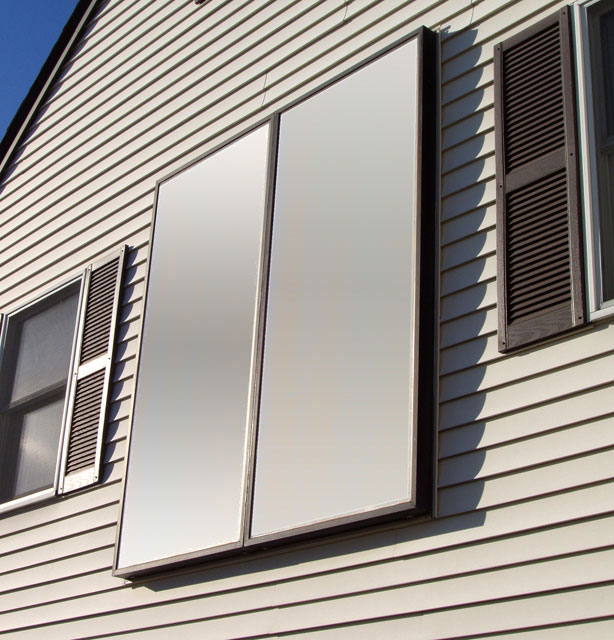
Image Credit: Image #1: Environmental Solar Systems
A solar hot air collector is basically a black box with glass on one side. Instead of heating fluid that circulates through tubing, a solar hot air collector is like a parked car. When the sun shines on the collector, the air inside gets hot. A solar hot air collector usually includes a hot air duct connection at the top and a return-air duct connection at the bottom. To improve efficiency, most solar hot air collectors have a black metal baffle or screen behind the glass that allows air flow on both sides.
Several manufacturers sell solar hot air collectors, including Your Solar Home of Aurora, Ontario (manufacturer of the SolarSheat collector) and Environmental Solar Systems of Methuen, Mass. (manufacturer of the SunMate collector). The SolarSheat 1500GS measures 43″ x 87″ (a little smaller than a sheet of plywood); it sells for $1,150 (without a fan) or $1,650 (with a PV-powered fan). The SunMate is smaller; it measures 34″ x 77″. Equipped with a thermostatically controlled 100-cfm fan (“turns on at 110°F and off at 90°F”), the SunMate sells for about $1,590.
These days, this type of solar collector is usually installed vertically on a south-facing wall. This makes sense, since vertical installation takes advantage of low sun angles during the winter. Manufacturers usually advise installers to drill a couple of 5-inch diameter (or larger) holes in the wall, penetrating the siding, sheathing, insulation, and drywall.
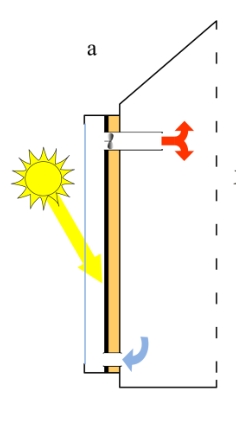
One of these holes is used for the hot air duct, and the other for the return air duct. These ducts terminate at indoor grilles installed on the drywall. In most cases, the hot air duct includes an inline DC fan that is powered by a wall cube transformer or a small PV module. The fan is usually controlled by a…
Weekly Newsletter
Get building science and energy efficiency advice, plus special offers, in your inbox.

This article is only available to GBA Prime Members
Sign up for a free trial and get instant access to this article as well as GBA’s complete library of premium articles and construction details.
Start Free TrialAlready a member? Log in





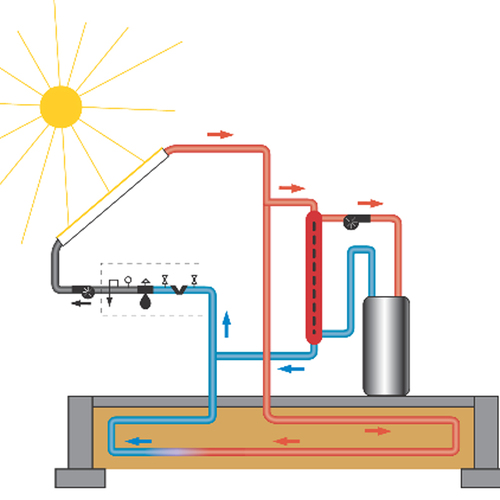
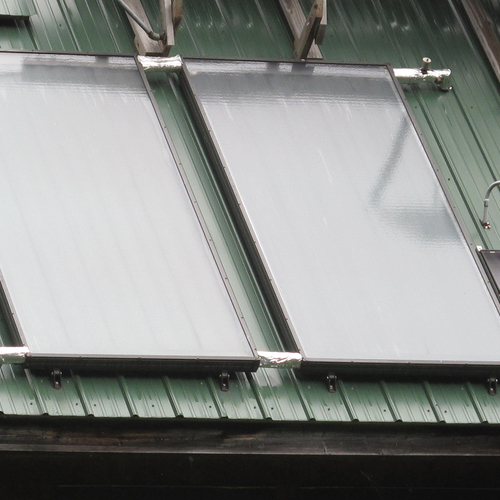
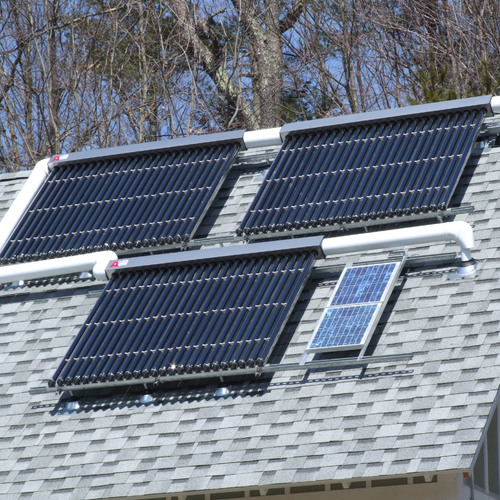







9 Comments
I Have Only One Comment
. . .about the last photo. Yikes.
Gems
Several things brought a smile to my face. The description of Mother Earth news as "the 1970s magazine known for optimistic articles with exaggerated claims". What Martin - do you really not believe you can bake bread for a family of eight in five minutes a day? And of course that roof mounted collector. What a fantastic find!
Martin, good article. Your
Martin, good article. Your right, it is very fun to experiment with this type of heating even if it isn't practical. Right now during my overhaul of my home I'm doing my own experiment. I've painted the entire bottom surface of the roof sheathing flat black. The idea is to get a low resistance path for the roof to reradiate heat downward. I've then covered the rafters in a radiation barrier to contain that radiation. It seems to work really well since even with the flat black paint my house was much cooler this past summer than previous summers.
I've connected that radiation barrier to two points at the very peak of the roof. The first is to a motorized damper vent that can open or close to release or contain the heated air to the atmosphere. The second is to a large (12" diameter) insulated duct that routes to the living space with another motorized damper in line with it. This is an open loop system, unlike the ones in your article, and is a high volume, low temperature system that works in connection with incoming air from the soffit vents. With temperature sensors installed the previous winter it worked on days when it was clear and the high of the day was only 46F it reached a temperature of 80 degrees F.
This is a long term experiment and won't be finalized and determined if it can be effective for many years. It is a system that only has the "potential" to work if used in a temperate climate like California or other southern tier states. The advantage is that it doesn't effect the look of the house in any way and can be decommissioned if necessary simply by opening one damper and closing the other. And it is also using the radiant barrier for cooling as well as heating. I'll see if it has any promise in the years to come.
when done right, it works right
Fun story Martin.
However, our Solar Sheet is airtight (proven during blower door test) with an electric damper that was improved upon by me and run by our solar PV system. Faces directly south and looks very nice between the door and the only two windows. At -15F it blows a consistent 85-90F air from 9am to 3pm in winter (NE Wisconsin). A good 3 pane tilt and turn window cost about the same. Our Solar Sheet does not loose heat during the cold evenings but keeps the house at 65F all day long without any other heat. Old house built North to South so not much choice on solar gain using windows.
There's always more to a story when it's done in perspective to the homeowner. I do agree that most advertising is a bit far fetched. You don't want to invest in these if your home isn't air tight and super insulated.
Response to Paul Kuenn
Paul,
I'm glad that you are happy with the performance of your solar hot air collector, and that your were able to modify the damper to make it more airtight.
I'm not convinced that it was a good investment, but your attention to airtightness is admirable -- and that approach should certainly be emulated by anyone contemplating the installation of one of these devices.
Forgot to mention
I did enclose the Solar Sheet within the last layer of 3" insulation so the sides are not exposed to weather and I'm sure that is why the performance is so good. While at it, I re-wire the 24V PV panel at it's top to do some extraneous work in the off season.
A trellis with pole beans placed in front of it love the extra warmth of it in summer. The soffit shades almost half of it during the summer months. Little extras always go a long way.
South Wall Air Heaters
Enjoyed your article Martin. It brought back some painful memories from the 70's when, sometimes, technical naivete and sales enthusiasm prevailed over efficiency or payback. I think that's where my long term insistence on collecting data after the project is completed comes from.
I do think that there is a place for retrofitting larger (cheaper?) South wall air collectors on metal shop buildings, warehouses and other commercial buildings. Building use and available hours of sun coincide quite nicely. Again, some monitoring is in order to improve designs and to assure cost effectiveness.
Commercial Solar Wall Installations
Great column Martin--no disagreement here. But as a point of discussion--solar walls do make some sense in commercial applications for preheating ventilation air when you have really high ventilation rates. I remember that an aircraft hangar was a good application of one commercial product. Also, there was a 2011 ASHRAE article talking about using it to preheat ventilation air in a school, where it goes through an ERV.
Of course, these commercial applications have maintenance folks working on them; also, they are not trying to really heat the building, as much as temper ventilation air (i.e., only "low quality" heat needed).
Response to Kohta Ueno
Kohta,
Thanks for your comments. My article focuses on residential applications; you're right, of course, that solar hot air collectors sometimes make sense for conditioning ventilation air for large commercial buildings.
Log in or become a member to post a comment.
Sign up Log in